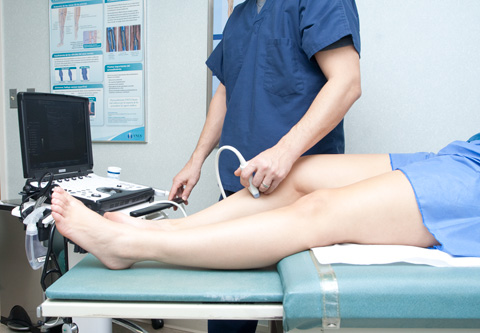Ultrasound examination of the vessels of the limbs shows a reliably assessment of the condition and disability of arteries or veins. The examination is painless for the patient and is considered the golden standard in vascular medicine. USG examination informs about the structure of the vessel, the patency and the rate of blood spread in the vessel and helps to determine the degree of vascular damage.
1.) Diseases of the arteries of the limbs
- peripheral artery disease of lower limbs (lack of blood supply of the lower limbs) is mostly often caused by atherosclerosis (hardening) of the arteries. Sonographic examination allows early diagnosis, monitoring of arterial narrowing (stenosis), as well as diagnosis of complete arterial obstruction with subsequent assessment of the condition with possible approach of interventional catheter therapy or surgical reconstruction.
- impression of an artery from the outside
- sudden blockage of the artery
- enlargment – i.e. arterial aneurysm
- inflammatory diseases of the arteries
- bleeding from an artery
- allows to monitor the blood flow of a previosly operated vessels (e.g. bypasses)
2.) Diseases of the veins of the limbs
- diseases of the superficial venous system: i.e. varicose veins, venous insufficiency, inflammation of superficial veins, etc.
- diseases of the deep venous system: deep vein thrombosis, post-thrombotic syndrome, deep vein valve insufficiency
- venous deformations
3.) Diseases of arteriovenous fistulas (entries for hemodialysis)
- hypofunction / hyperfunction
- occlusion
- narrowing (stenosis)
- thrombosis (clot)
4.) Diseases of the lymphatic system of the limbs
- the most common manifestation of lymphatic system disease is lymphatic swelling (lymphedema)of the upper/lower limb, but may also occur on other parts of the body
The examination should be performed:
- if upper or lower limb pain is present
- if swelling of the upper or lower limb is present
- if stiffness of the calf or thigh is present on one side, usually painful after compression
- if the skin color of the limb has changed (white, blue, black, red, or red painful stripe)
- if the limb temperature has changed (cold or significantly warm)
- if a wound has formed on the limb of unclear cause or the wound does not heal for a long time (ulcers, frequent wounds on the fingers)



